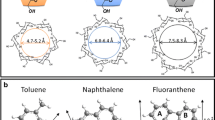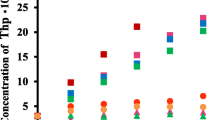Abstract
The inclusion complexation of five volatile chlorinated hydrocarbons, i.e., chloroform, carbon tetrachloride, trichloroethylene, tetrachloroethylene, and monochlorobenzene, with branched cyclodextrins (CDs) such as monoglucosyl-α-CD and monomaltosyl-β-CD in aqueous solutions was examined. Their inclusion complexes were found to be very water soluble and the solubilities of the chlorinated hydrocarbons in aqueous solutions increased almost linearly or gradually with increasing concentration of the branched CDs. The amounts of the chlorinated hydrocarbons included in the branched CDs were well related to their molecular size and shape. In addition, the viability of application to pollution prevention is discussed.
Similar content being viewed by others
Notes and References
I. Uemasu:J. Incl. Phenom. 13, 1 (1992).
S. Kobayashi, K. Kainuma and D. French:Proc. 1st Int. Symp. Cyclodextrins, p. 51, Akademiai Kiado, Budapest 1982.
Y. Okada, Y. Kubota, K. Koizumi, S. Hizukuri, T. Ohfuji and K. Ogata:Chem. Pharm. Bull. 36, 2176 (1988).
Tetrachloroethane, lemon oil, etc., which form insoluble complexes with α-CD, became very water soluble through inclusion by monoglucosyl-α-CD (G-α-CD) [2]. The water solubility of G-α-CD (0.80 M at 25°C) is more than four times that of α-CD and that of monomaltosyl-β-CD (1.04 M at 25°) is about sixty times that ofβ-CD [3].
About 20 halogenated organic compounds were included in 189 substances regulated by the 1990 Clean Air Act of the United States. The five compounds treated in this study are all listed in the 1990 Clean Air Act.
C & EN 70 (20), 25 (1992); J. Szejtli:Book of Abstracts of the 6th International Cyclodextrin Symposium, L-38, Chicago, 1992.
D. French, M.L. Levine, J.H. Pazur and E. Norberg:J. Am. Chem. Soc. 71, 353 (1949).
J. Szejtli:Cyclodextrins and Their Inclusion Complexes, pp. 223 and 261, Academiai Kiado, Budapest, 1982.
J. Szejtli:Cyclodextrin Technology, pp. 102 and 393, Kluwer Academic Publishers, Dordrecht, 1988.
Branched CDs have glucosyl or maltosyl units in the primary hydroxyl groups of the narrow rims joined through 1,6-α linkages and their wider rims undergo no modification. Their inclusion characteristics, therefore, are expected to be very similar to those of unsubstituted CDs.
The results are slightly different from those of Ref. 7. But the general trend was almost the same. The difference should be attributed to the experimental methods.
F. Cramer:Einschlussverbindungen, p. 51, Springer-Verlag, Berlin, 1954.
Branched CDs have been mainly applied to foods. For example, seeJpn. Fudo Saiensu 27, 66 (1988) (Chem. Abstr. 109, 36663b (1988).
Author information
Authors and Affiliations
Rights and permissions
About this article
Cite this article
Uemasu, I., Kushiyama, S. Inclusion complexation of volatile chlorinated hydrocarbons in aqueous solutions of branched cyclodextrins. J Incl Phenom Macrocycl Chem 17, 177–185 (1994). https://doi.org/10.1007/BF00711857
Received:
Accepted:
Issue Date:
DOI: https://doi.org/10.1007/BF00711857




